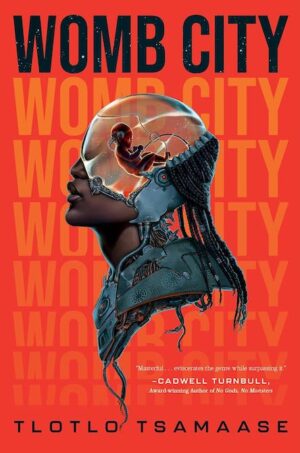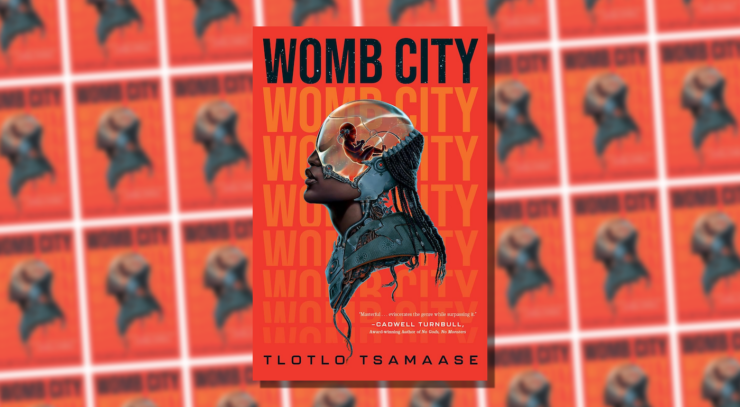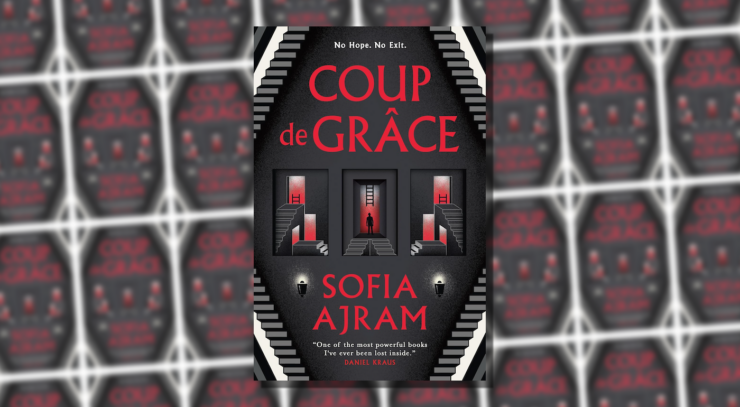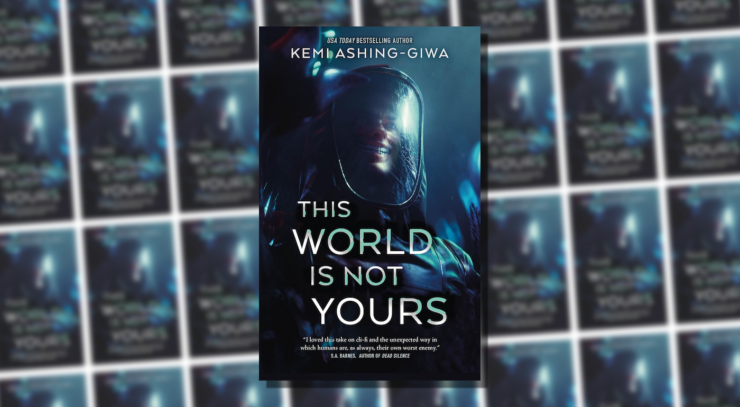In much of the SFF centering mothers, the nature of parenthood is all-consuming, with whatever high-concept premise acting as a direct metaphor for the transformative acts of conceiving, carrying, and caring for a newborn. But despite Tlotlo Tsamaase’s debut novel being called Womb City, xe cleverly approaches the premise sideways: Because protagonist Nelah Bogosi-Ntsu is infertile, she is obsessed with the possibility of motherhood yet exists in the constant Schrödinger’s identity crisis that plagues all those suffering from infertility: No matter what treatment you’re in the middle of, life simply goes on; and there is no guarantee as to when, if ever, these timelines—yourself as a mother, versus yourself not as a mother—will converge.
Matching this, Womb City is about motherhood and body-hopping and a criminal surveillance state and a vengeful ghost and Botswana folklore. It’s an ambitious tapestry of intersecting ideas that is unfortunately snarled by overwritten passages and stop-and-start exposition that makes it difficult to fully invest emotionally in Nelah’s struggle to retain ownership of her latest body and the future she so desires. The parts that hit are a gut-punch; the parts that miss muddle Tsamaase’s incisive critiques of sexism, class, and who we preemptively label a “criminal.”
The book takes place in near-future Botswana, though it quickly becomes apparent that “near” is a relative term; Nelah is on her third full lifespan, having waited fifteen years between bodies, so the present action is already several generations removed from our own. Body-hopping is a global advancement, yet each country has its own cultural rules and immigration policies mostly keeping reincarnated citizens within their respective borders, though of course there are always exceptions for the rich. And if you are as especially unlucky as Nelah, to receive a body marked for previous criminal activity, you’re considered damaged goods; the body is microchipped so that the Criminal Behavior Evaluator can monitor its potential to commit a crime. It’s Minority Report meets Altered Carbon by way of the tauntingly-named Body Hope Facility, which is also connected to the magical pools from which nonbinary god Matsieng is said to have risen long ago, bringing with Xem Nelah’s ancestors.
Botswana’s surveillance state is an apt metaphor for infertility, as everyone seems to know the inner workings of Nelah’s body except for her. Nothing is private; daily check-ins via microchip and chirpy female AI are a constant diminishment of her agency and invasion of her biometrics. If she wants to not be berated for even the smallest infraction, she must lie about what reaction her body is having to the interrogation—daily, weekly, and annually; trapping her in a constant state of fight-or-flight trying to trick the system but also waiting to be caught. And the simulations! The CBE’s penchant for occasionally thrusting its subject into virtual reality scenarios to test their purity is such a unique cruelty for someone who already tortures themself imagining potential futures.
Buy the Book


Womb City
To add insult to injury, what Nelah most wants out of this season in her body is to succeed at her architectural firm and to start a family. But because this body is unable to carry a pregnancy to term, having suffered more than one traumatizing stillbirth, the only option for her and policeman husband Elifasi is to pay out the nose for the latest advancement in IVF: the Wombcubator, which will artificially incubate their fetus, so long as they don’t miss their monthly payments to the Matsieng Fertility Fund… and so long as Nelah remains “pure.”
Infertility is learning so much about your body that you don’t already know; Tsamaase cunningly extends that discomfort into Nelah being implanted into a body whose history is hidden from her. Her kindly yet distant adoptive family won’t tell her what made the prior two hosts leave this vessel, nor how she came to have a cybernetic arm. Not to mention the lack of insight into why she has suffered multiple miscarriages; all she can do is blame her own “Black Womb,” as the press devastatingly refers to her uterus, without understanding the conditions of this temporary form. All Nelah knows is that these factors make her feel not only like less of a woman, but less of a person. Eli is wholly unsympathetic, seeming to resent her for both the infertility and the microchip, yet also lords his control over her; despite her assertions that when they met a decade ago they were happy, there is no evidence of that now.
It’s no surprise, then, that Nelah would seek an outlet from her emotionally abusive marriage, in a thrilling affair with VC investor and rich boy Janith Koshal. An especially nasty simulation from the CBE propels Nelah to throw caution to the wind and fake work projects to cover their trysts, high on their forbidden attraction—he is in the midst of a divorce, complicated by having twin daughters—as well as whatever illicit drugs Jan has been able to procure.
A middle-of-the-night joyride culminates in a hit-and-run; the victim, a young woman in the wrong place at the wrong time. Fueled by panic that she will be not only evicted from this body but her consciousness jailed for life, Nelah kills the girl, Moremi, and does everything in her power to cover up the evidence. But while she has become an expert at fooling her microchip, she does not anticipate Moremi’s vengeful ghost stalking her waking life—and demanding the lives of her parents, partner, and even her unborn daughter as reparation.
The fact that it has taken this far through the review to set up Womb City speaks to the fact that there are simply too many fascinating ideas all crammed into one book. The impressively conceptualized worldbuilding is communicated via infodumps that make the forward momentum stutter awkwardly; for one, it takes a while for the reader’s confusion between lifespans (70 years) versus seasons (the number of bodies, as some stays may be cut short due to premature death or a crime committed) to be completely clarified.
Frequent asides filling in minute details of the world detract from the momentum of Nelah and Jan trying to protect their loved ones from Moremi while still saving their own hides. This is further complicated by their ersatz investigation into a conspiracy involving Matsieng and the ominous Murder Trials employed by the CBE. By the time that Tsamaase introduces especially fascinating concepts, like the notion that body-hoppers don’t often choose the same gender each time, it’s frustrating to not be reading that story about Nelah and to have it exist as no more than a bit of hypothetical worldbuilding.
Despite the fact that they’re linked by their complicity in Moremi’s murder, there is an inherent flaw in the pairing of Nelah and the spoiled, ineffectual Jan, in that he is simply not a man worth covering up a murder for… but then again, neither is the petty, jealous, controlling Eli worth being loyal to. The apparent takeaway being, men ain’t shit.
In fact, the book’s truly unbroken link is between mothers and daughters, older women and younger—even if they appear the same age, the contrast of lived experience between a three-time body-hopper like Nelah and someone like Moremi, whose first lifespan is brutally cut short and who has no way to reincarnate. Moremi’s bloodlust is compelling, gripping in a way that Nelah’s own rebellion fails to be. The younger generation is always going to galvanize with their deeper well of anger and their willingness to actually do something about it.
True to its opening establishing the Wombcubator technology, the book ends big and bloody, like a birth—or more accurately, a rebirth. It’s an escalation from this bloodless act of conception to the goriest of tabula rasas; like IVF, it brings its participants to the same state as those who conceive “naturally,” yet they are changed in a way that no one else can fathom unless they have lived it in their bones, too.
Womb City is published by Erewhon Books.














